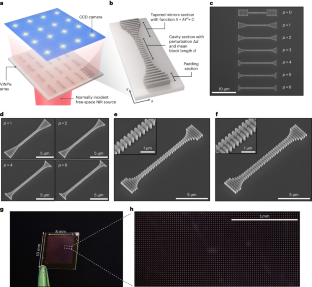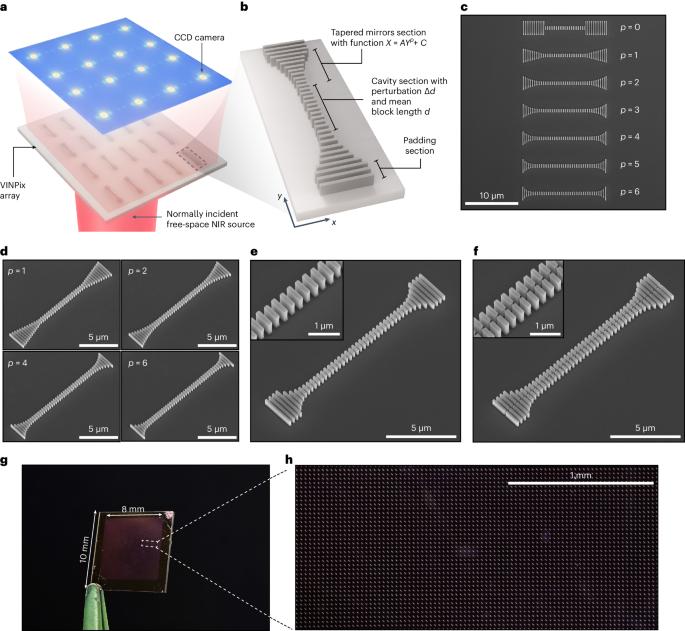超大规模集成高质量因子纳米天线像素
IF 38.1
1区 材料科学
Q1 MATERIALS SCIENCE, MULTIDISCIPLINARY
引用次数: 0
摘要
元表面可精确控制光的振幅、偏振和相位,其应用领域涵盖成像、传感、调制和计算。元表面及其组成谐振器的三个关键性能指标是品质因数(Q 因子)、模式体积(Vm)和控制远场辐射的能力。通常,谐振器需要在这些参数之间做出权衡:减小 Vm 会导致 Q 值的等效减小,尽管对辐射的控制能力更强。在这里,我们证明了这种折衷并非不可避免:高品质因数、亚波长 Vm 和受控偶极辐射可以同时实现。我们设计了高品质因数、超大规模集成硅纳米天线像素(VINPix),它将导模谐振波导与光子晶体腔体结合在一起。通过优化纳米天线,我们实现了超过 1,500 的 Q 系数,Vm 小于 0.1 ({(\lambda /{n}_{{{{\rm{air}}}}})}^{3}\ )。每个纳米天线都可通过自由空间光单独寻址,并向远场显示偶极散射。谐振器密度可超过每平方厘米一百万个纳米天线。作为概念验证应用,我们展示了无光谱仪、空间定位、折射率传感以及 8 毫米 × 8 毫米 VINPix 阵列的制造。我们的平台为空间光调制器、计算光谱仪和现场环境传感器等紧凑型高密度多路复用设备奠定了基础。本文章由计算机程序翻译,如有差异,请以英文原文为准。


Very-large-scale-integrated high quality factor nanoantenna pixels
Metasurfaces precisely control the amplitude, polarization and phase of light, with applications spanning imaging, sensing, modulation and computing. Three crucial performance metrics of metasurfaces and their constituent resonators are the quality factor (Q factor), mode volume (Vm) and ability to control far-field radiation. Often, resonators face a trade-off between these parameters: a reduction in Vm leads to an equivalent reduction in Q, albeit with more control over radiation. Here we demonstrate that this perceived compromise is not inevitable: high quality factor, subwavelength Vm and controlled dipole-like radiation can be achieved simultaneously. We design high quality factor, very-large-scale-integrated silicon nanoantenna pixels (VINPix) that combine guided mode resonance waveguides with photonic crystal cavities. With optimized nanoantennas, we achieve Q factors exceeding 1,500 with Vm less than 0.1 $${(\lambda /{n}_{{{{\rm{air}}}}})}^{3}$$ . Each nanoantenna is individually addressable by free-space light and exhibits dipole-like scattering to the far-field. Resonator densities exceeding a million nanoantennas per cm2 can be achieved. As a proof-of-concept application, we show spectrometer-free, spatially localized, refractive-index sensing, and fabrication of an 8 mm × 8 mm VINPix array. Our platform provides a foundation for compact, densely multiplexed devices such as spatial light modulators, computational spectrometers and in situ environmental sensors. An optimized design of free-space silicon nanoantennas combines high quality factor and low mode volume, reducing the trade-off between these parameters.
求助全文
通过发布文献求助,成功后即可免费获取论文全文。
去求助
来源期刊

Nature nanotechnology
工程技术-材料科学:综合
CiteScore
59.70
自引率
0.80%
发文量
196
审稿时长
4-8 weeks
期刊介绍:
Nature Nanotechnology is a prestigious journal that publishes high-quality papers in various areas of nanoscience and nanotechnology. The journal focuses on the design, characterization, and production of structures, devices, and systems that manipulate and control materials at atomic, molecular, and macromolecular scales. It encompasses both bottom-up and top-down approaches, as well as their combinations.
Furthermore, Nature Nanotechnology fosters the exchange of ideas among researchers from diverse disciplines such as chemistry, physics, material science, biomedical research, engineering, and more. It promotes collaboration at the forefront of this multidisciplinary field. The journal covers a wide range of topics, from fundamental research in physics, chemistry, and biology, including computational work and simulations, to the development of innovative devices and technologies for various industrial sectors such as information technology, medicine, manufacturing, high-performance materials, energy, and environmental technologies. It includes coverage of organic, inorganic, and hybrid materials.
 求助内容:
求助内容: 应助结果提醒方式:
应助结果提醒方式:


